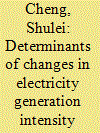|
|
|
Sort Order |
|
|
|
Items / Page
|
|
|
|
|
|
|
| Srl | Item |
| 1 |
ID:
168339


|
|
|
|
|
| Summary/Abstract |
This study analyzes the determinants of changes in electricity generation intensity in China and further uncovers the reasons for the differences between the changes in electricity generation intensity in the thermal and sustainable power sectors. By developing a factorial-intertemporal nested decomposition technique using the refined Laspeyres index, we demonstrate the contributions of electricity generation structure, electricity generation-to-consumption ratio, production electricity consumption intensity, residential electricity consumption intensity, and electricity consumption loss intensity effects. Although the electricity generation intensity of the thermal power sector has been lower than that of the sustainable power sector, the latter has declined remarkably and has remained the key sector driving the overall changes in electricity generation intensity. Meanwhile, the effect of electricity consumption intensity is the main factor that reduces electricity generation intensity. Moreover, the impact of production electricity consumption intensity in the thermal power sector exceeds its impact in the sustainable power sector. Ultimately, we find that the differences between the changes in electricity generation intensity in the thermal and sustainable power sectors are mainly due to their differences in production electricity consumption intensity.
|
|
|
|
|
|
|
|
|
|
|
|
|
|
|
|
| 2 |
ID:
149994


|
|
|
|
|
| Summary/Abstract |
Coal is one of the main fuel sources in China. This paper sheds light on the evolution of China's interregional differences in CO2 emissions from coal by constructing a Gini coefficient and decoupling elasticity index for emissions from 1997 to 2012 and explains why emission differences deviate from economic growth differences. The study decomposed the Gini coefficient of CO2 emissions from coal by source, incremental source, and region. It also divided the decoupling elasticity of carbon emissions into two components: effects of environmental expenditure and effects of emission reduction policy. The findings of the study are as follows: First, interregional differences in China's overall CO2 emissions from coal are characterized by periodic fluctuation. Second, the differences in emissions from raw coal, the concentration effect of emissions, and the emission differences within regions are the three main factors in the overall difference changes in coal's carbon emissions in China. Last but not least, the decoupling between provincial CO2 emissions from coal and economic growth is on the whole weak. Based on the above findings, the author offers four suggestions for emission reduction.
|
|
|
|
|
|
|
|
|
|
|
|
|
|
|
|
| 3 |
ID:
193746


|
|
|
|
|
| Summary/Abstract |
Fiscal environmental expenditure (FEE) is crucial to achieving climate change mitigation targets; however, its role in reducing household carbon emissions has received little attention. By matching household-level data from the Chinese General Social survey 2015; Cgss 2015) with city-level data, this study investigated the impact of FEE on household carbon emissions. The results show that FEE significantly increased household carbon emissions through reduced satisfaction with environmental governance. Meanwhile, public service satisfaction, household income, energy intensity and location are important moderating mechanisms. Moreover, FEE has a more significant impact on carbon emissions for households with urban hukou status and light burdens, as well as for those living in big northern cities with a slow GDP growth rate. This study reveals the unexpected mechanism underlying FEE's impact on carbon emissions in the household sector.
|
|
|
|
|
|
|
|
|
|
|
|
|
|
|
|
|
|
|
|
|